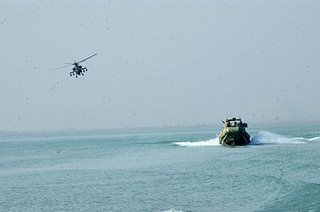At Michael J. Totten: Busted ..
It's a tricky world.
H/T: American Thinker
"We must be ready to dare all for our country. For history does not long entrust the care of freedom to the weak or the timid. We must acquire proficiency in defense and display stamina in purpose." - President Eisenhower, First Inaugural Address
Tuesday, January 30, 2007
Tuesday's referral to Maritime Monday 44 at Fred Fry International
Get thee to Fred Fry International: Maritime Monday 44. Sure, it was posted yesterday, but I've been out of town while Fred's been collecting all kinds of good maritime stuff that will get you through a week until next Monday.
Monday, January 29, 2007
How Eisner did it

Take this report:
During his 21-year tenure at Disney, Michael Eisner grew the company from US$7 billion to US$20 billion in in revenue. Eisner recently spoke to a group of Toronto businesspeople and revealed how he did it.Eisner took over Disney in, what, 1984? And stayed there 21 years.
During that time, how much was the growth due to inflation (the article doesn't seem to use constant dollars...).
Well, if you go here, there are calculators.
To make it simple, let's say the $7billion is represented by $7. If you had $7 in 1984, what would you end up with in 2005 after adjusting for inflation? The answer:
In 2005, $7.00 from 1984 is worth:So, it appears that Mr. Eisner did preside over an increase in revenue while a Disney- an increase of $7 billion (using the CPI and rounding down) in 2005 dollars.
$13.16 using the Consumer Price Index
$11.66 using the GDP deflator
$13.42 using the unskilled wage
$17.66 using the nominal GDP per capita
$22.17 using the relative share of GDP
However, that increase represented in 1984 dollars is not $7 billion, but rather something less:
In 1984, $7.00 from 2005 is worth:So, if I have made the comparison properly, Mr. Eisner did not almost triple Disney revenue during his tenure, but grew it about 50% in constant 1984 dollars, roughly 2.5% per year above the inflation rate.
$3.72 using the Consumer Price Index
$4.20 using the GDP deflator
$3.65 using the unskilled wage
$2.77 using the nominal GDP per capita
$2.21 using the relative share of GDP
Of course, I might be wrong.
If I am, the comment section is open.
2007 MilBlog Conference

Info here.
Yes, I'll be there -on a panel with (so far) John of the Castle Argghhh!, Noah Shachtman of DefenseTech, LTC P of Opfor, and Murdoc.
As Andi describes it, "an eclectic mix of milbloggers."
Probably an understatement.
Best part is that I like the work of everyone else on the panel and look forward to meeting them.
And everyone else, too.
We mourn our shipmates
The toll of the H-60S crash off San Diego set out here.
Beat the drum slowly.
Beat the drum slowly.
Lord, guard and guide the men who fly
Through the great spaces in the sky,
Be with them always in the air,
In dark'ning storms or sunlight fair.
O, Hear us when we lift our prayer,
For those in peril in the air.
Navy

Sailors going to sea, manning the rails.
From here. Caption:
On the flight deck aboard the Nimitz-class aircraft carrier USS Ronald Reagan (CVN 76) Sailors man the rails, as final preparations are made for getting underway for deployment. Ronald Reagan and attached ships of the Reagan Carrier Strike Group (CSG) surge deployed to the 7th Fleet Area of Operations from Naval Station North Island on Jan. 27. Surge deployments are part of the Navy’s Fleet Response Plan (FRP), which ensures ships are able to respond to real-world situations by maintaining high states of readiness during their surge windows. The Reagan CSG is comprised of, the nuclear-powered aircraft carrier Ronald Reagan, Commander Carrier Strike Group 7 (CCG 7), Carrier Air Wing (CVW) 14, Destroyer Squadron (DESRON) 7, the guided-missile cruiser USS Lake Champlain (CG 57), the guided-missile destroyer USS Russell (DDG 59), and Explosive Ordnance Disposal Unit 11, Detachment 15.U.S. Navy Photo by Mass Communication Specialist 2nd Class John P. CurtisFair winds!
Sri Lanka: Tamil "Sea Tigers" take another beating


The Tamil rebel/terrorist "Sea Tigers" attempted to attack the container port of Colombo and the Sri Lankan Navy "destroyed" three of their boats, as reported here:
The Sri Lanka Navy destroyed three Tamil Tiger boats which were attempting to attack the Colombo harbor, considered one of the busiest container ports in South Asia.The "Sea Tigers" lead the way in use of sea-going terrorism. The boats pictured are "Sea Tiger" armed attack vessels.
The Sri Lanka navy said they destroyed the three boats which were trying to attack the Rangala Naval base which is located in the center of the Colombo's commercial port.
The boats sank with unknown number of Sea Tigers in the boats except three who jumped off a boat . The Army sources said those three and three other suspects were later arrested.
The Sri Lanka Navy spotted the three Tiger boats entering the restricted zone and immediately opened fire on them. One boat sank, and the Navy gun boats started chasing the other two boats which were also destroyed after a while.
The Ministry of Defense said the attempt of the Liberation Tigers of Tamil Eelam (LTTE) was "successfully foiled."
The LTTE tried to enter the Colombo port in 1996 and fired rocket propelled grenades at foreign ships but they were completely destroyed by the navy gun boats then. Following the attack the government banned fishing near the Colombo port tightening the security with a marked security zone.
***
avy spokesman Rear Admiral B.A.G.G.Peiris said, a foreign vessel flying under a Panamanian flag, "Pelaponesia Pride" was damaged by the explosion of the second Tamil Tiger boat . He said, "A container burst open and came off its original position as a result of the shockwaves." Peiris said the vessel was not hit by navy fire. The ship was coming from Jeddah, Saudi Arabia and heading for a berth at Colombo port, he said.
Port authorities said due to the gun fire the work of the port was disrupted briefly but it came back to normal . In a visit to the Port, Ports Minister Mangala Samaraweera said that the foiled attack proved that the Colombo port was one of the safest ports in the world.
The attack came soon after Police raised security one day before on Friday suspecting rebel attacks in the South. Intelligence said the rebels were preparing to attack South in revenge after losing Vakarai. About 38 people were arrested on suspicion on Friday for questioning.
In June 2006 suspected Sea Tigers also laid sea mines in the North West coast to destroy naval vessels patrolling the area.
Earlier posts on Tamil maritime operations here and here.
Everything old is new again: Prison ships

Reported as Ships to Ease Overcrowding for British Prisons.
In his book on the origins of modern Australia, The Fatal Shore: The epic of Australia's founding, Robert Hughes spends some time describing the wretched condition of the ships used as "prison hulks" before the prisoners were loaded onto other ships to be sent to Australia in the late 18th and early 19th centuries. More here.
Their use during the American revolution, well-
More Americans died in British prison ships in New York Harbor than in all the battles of the Revolutionary War.
And, as noted here, there have been more recent uses, as occurred off Palestine in 1947:
In Haifa, British soldiers transferred the Exodus 1947 passengers, exhausted from the sea journey and the battle, to three freighters converted into caged prison ships. Thereby began Operation Oasis.The ships eventually ended up in Germany with the refugees being forced to leave the ships.
The next day, the three caged prison ships, the Ocean Vigour, the Runnymede Park, and the Empire Rival, departed Haifa with the Exodus passengers. 1,464 people were accommodated on the Ocean Vigour, around 1,409 on the Runnymede Park and 1,526 were crammed into the belly of the Empire Rival.
The refugees assumed they, as illegal emigrants, would be interned in camps on the island of Cyprus. What was initially a rumour was later confirmed: the three prison ships were sailing towards the European mainland, back towards France.
The conditions on board these ships were terrible. The refugees lay crammed together in the bare holds of the freighters.
Not a happy history of "prison ships."
Plus ça change, plus c'est la même chose.
MSC Napoli Update: Getting the containers off
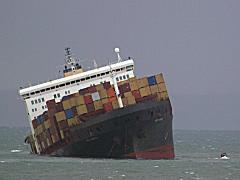
After some delay caused by mechanical isues, divers are going aboard to check on container locations and heavy lift cranes are positioning thmeselves for offloading containers, as set out here:
A team of about 20 salvage operators will be involved, some of them divers, who will go into the ship which has been flooded with water and oil.
The divers will be putting their lives at risk when they move around the precariously positioned containers to find the best ways of getting them off.
***
Mr Clark said they would have to take the "greatest of care" with such a dangerous work area.
"The vessel is at an acute angle with crushed containers and spilling goods. People have to get on those containers and secure heavy chains so it's a very dangerous job," he said.
"Their lives are more valuable than the cargo."
Sunday, January 28, 2007
Sunday Ship History: U.S. Navy "Cable Repair Ships"

That undersea cables are laid by ships should not be a surprise to anyone. Transoceanic telegraph, telephone and other lines have linked the continents for nearly 150 years. In fact, 2008 will be the 150th anniversary of the first cable. The first U.S. Navy ship involved in cable laying was USS Niagara, laying a cable on a path selected in part by famed Navy oceanographer Matthew F. Maury. This early cable eventually failed, but in 1866, the Great Eastern laid
a successful cable which was soon joined by others.
However, the U.S. Navy was out of major ocean cable operation for almost 100 years. World War II spurred a revival of interest in underwater cable laying, especially because of concerns of Soviet Union exploitation of the German submarine Type XXI:
The Second Battle ended as the Germans were deploying a new type of submarine designed to counter the ASW techniques used by the Allies to defeat their wolf packs operating on the surface. Known as the Type XXI, it combined three design changes to enable a radically new operational approach focused on submerged operations. These changes were greater battery capacity, a hull form more hydrodynamically suited to high underwater speed, and a snorkel allowing the main diesel engine to breathe from periscope depth.The war also lead to a number of other scientific breakthroughs in underwater sound propagation, which, in turn lead to new experiments in tracking submarines:
The Type XXI undermined each element of the Allied ASW posture that won the Second Battle. The snorkel, which had a much lower radar cross section than a surfaced submarine, gave the submarine back its tactical mobility. That is, it could once again move at speed on its main engine for great distances without molestation by air ASW forces. A more hydrodynamic hull and greater battery power allowed a completely submerged submarine to go faster for longer than before, allowing it to escape prosecution by sonar-equipped convoy escorts once it had revealed its position by attacking.
At the operational level, Type XXIs deployed in sufficient numbers to blanket the North Atlantic shipping lanes would minimize the need for shore-based command and control, and to the extent that two way communications between deployed submarines and headquarters remained necessary, they could be executed using the new "kurier" burst transmission technology introduced by the Germans at the end of World War II. Burst transmissions compressed HF signals enough to make it difficult to DF them. Combined with the likely absence of a code breaking triumph such as Ultra, a future Battle of the Atlantic would therefore be prosecuted without much of the operational intelligence of opposing submarine operations that the Allies enjoyed in the Second Battle.
Type XXIs had fallen into American, British, and Soviet hands after World War II, and the U.S. Navy rapidly discovered that it would face a major ASW challenge were the Soviet Navy to build large numbers of ocean going Type XXIs. In anticipation of this threat, then CNO Admiral Nimitz identified ASW as equal in importance to dealing with the threat of atomic attack.(8) The resulting ASW response to the fast snorkel threat initially unfolded in two basic directions: an evolutionary path that sought to repair the ASW team that won the Second Battle, and a more revolutionary path that aspired to replace it.
The evolutionary response to the fast snorkel boat emphasized at the technical level better radars for air ASW assets, better active sonars for surface escorts, and better weapons for both, along with a tightly integrated tactical approach that sought to exploit the strengths and compensate for the weaknesses of each ASW platform. This approach took advantage of the fact that a snorkel boat still was not a true submarine, in that it remained at least partially wedded to the surface, albeit in a fashion that greatly reduced its vulnerability.
The more revolutionary response introduced both a new sensor and a new platform into the ASW equation. The new sensor was the passive acoustic array and the new platform was the ASW submarine, or SSK. American passive acoustic array development grew out of earlier German developments, in this case the GHG array first used on a limited basis as a torpedo-self defense sensor on German surface ships, and later adapted for use by Type XXIs as a means of tracking and targeting surface ships for torpedo attack while submerged. Fortuitously, the U.S. Navy discovered in early postwar exercises that submarines were quite loud when snorkeling. Compared to a surface ship, a snorkeling sub put all of its machinery noise into the water because it was submerged, and if it was to make best progress during transits to and from its operating areas or keep up with a fast convoy, it needed to operate at speeds well past the onset of propeller cavitation at such shallow depths. For both reasons, it was an excellent target for a quiet platform deploying a large, low frequency passive array.
Passive acoustic-based ASW methods grew out of discoveries about low frequency sound propagation in the sea made during and immediately after World War II. One key discovery, made by Maurice Ewing and J. Lamar Worzel, was of a deep sound channel that trapped and focused low frequency sound, allowing it to propagate over great distances. It was abstracted as follows when first discussed in the open literature in 1948:Ah, SOSUS!
"Experiments are described to demonstrate a new method of sonic signaling at extremely long ranges in the oceans, utilizing the natural sound channel. Signals were made by causing a 4-lb. charge of TNT to explode at about 4000-foot depth. These signals have the following qualities:
Extremely long-range transmission (probably 10,000 miles).
Signal is positively identifiable.
Abrupt termination of the signal allows the arrival time to be read with an accuracy better than 0.05 second. This permits location of the source to within a mile, if the signal is received at three suitably located stations.
The relation of signal duration to distance is such that the distance may be estimated to 30 miles in 1000 from reception at a single station
The limitations are:
The great-circle path which the sound follows between source and receiver must lie entirely in deep water (probably at least 1000 fathoms).
Sound travels in water at about 1 mile per second, so that the interval between the origin of the signal and its reception becomes sufficiently great to be a handicap for some uses"
The so-called SOFAR (SOund Fixing And Ranging) channel was first used as a means of locating downed aviators at sea,(11) then as a missile impact location system,(12) but its most important application came in the form of SOSUS (SOund SUrveillance System), the network of seabed, listening arrays deployed by the Navy to listen for submarines in the deep, SOFAR channel. SOSUS began as a crash program by Bell Labs in October 1950 under the direction of the Navy's Office of Naval Research.(13)
As a key result of the Project Hartwell findings, the Office of Naval Research (ONR) in late 1950 funded a contract with the American Telephone and Telegraph company (AT&T) and its manufacturing arm, Western Electric, to develop an undersea surveillance system based on long-range sound propagation. Under this aegis, Bell Telephone Laboratories initiated a series of experimental trials by installing undersea listening arrays off Sandy Hook, New Jersey and Eleuthera in the Bahamas. Additionally, AT&T adapted its sound spectrograph, which had recently been invented as a tool for analyzing speech sounds, into a similar device called LOFAR - for Low Frequency Analysis and Recording - designed to analyze low-frequency underwater signals in near-real time. Both LOFAR and the spectrograph generated a frequency-versus-time representation of an incoming sound "bite" on which the time history of its spectral content was indicated by the blackening of specially-sensitized paper by an electrostatic stylus that swept repeatedly along the frequency axis. In this way, the presence of distinctive submarine sound signatures - comprising both broadband noise and discrete frequency components ("tonals) - could be discerned against the ocean background in the composite signal picked up by an array. This body of work, largely at AT&T, was code-named Project Jezebel and placed under the direction of CAPT Joseph Kelly at the Bureau of Ships.And to get SOSUS arrays laid under the sea, the Navy got cable layers starting in 1952:
Meanwhile, the Navy continued to support Maurice Ewing, by then at Columbia University's Hudson Laboratory, to study the general phenomenology of low-frequency underwater sound. This effort, augmented by additional work at Woods Hole and the Scripps Institution of Oceanography in California, was focused on establishing a solid understanding of long-range sound transmission and denoted Project Michael. When the findings of Projects Jezebel and Michael were brought together for the purpose of designing, engineering, and deploying the broad-area surveillance system envisioned by Hartwell's Frederick Hunt, the resulting effort- with the highly classified acronym, SOSUS - was eventually given the unclassified designation, Project Caesar.
The first prototype of a full-size SOSUS installation - a 1,000-foot-long line array of 40 hydrophone elements in 240 fathoms of water - was deployed on the bottom off Eleuthera by a British cable layer in January 1952. After a series of successful detection trials with a U.S. submarine, the Navy decided by mid-year to install similar arrays along the entire U.S. East Coast - and then opted two years later to extend the system to the West Coast and Hawaii as well. These early SOSUS line arrays were positioned on the sea floor at locations that accessed the deep sound channel and oriented at right angles to the expected threat axis. Their individual hydrophone outputs were transmitted to shore processing stations called "Naval Facilities" - or NAVFACs - on multi-conductor armored cables.
At the NAVFACs, the acoustic signals were processed to create a fan of horizontal "beams," each of which represented the composite sound signal from a small angular sector - on the order of two to five degrees wide - oriented in a particular azimuthal direction. Narrow-band time-frequency analysis in the spectral region was performed on these multiple beam outputs simultaneously using the LOFAR technique described above. The ability of narrow-band frequency analysis not only to discriminate against broadband ocean noise but also to identify characteristic frequencies associated with rotating machinery was key to detecting and classifying targets. A LOFAR analyzer was associated with each beam of each array served by a NAVFAC, and typically, the large watch floors were filled with hundreds of these "gram-writers" busily turning out LOFARgrams on "smoky paper" 24 hours a day. These records were scrutinized continually by specially-trained personnel looking for the distinctive submarine "signatures" which gave indication of a possible target along a given bearing line. Then, if simultaneous contacts were gained on multiple arrays in separated locations, the target's position could be estimated by triangulation.
*CNO Directs BUSHIPS to procure six sets of LOFAR station components for deployment in the North Atlantic basin in a Top Secret letter.
*Classified name SOSUS is established.
*Unclassified name CAESAR established to cover installation and production.
*Number of stations planned is increased to nine.
*HMS Alert installs initial 40-element operational array off Eleuthera
Bahamas (2-19 January) total cost for 50-day charter is $56,400 ($840/day plus
fuel). (Photo is of NavFac Adak)
*Cable ships Neptune and Myer assigned to Project CAESAR: the humble
beginnings of the "CAESAR Fleet" to later include: Thor, Aeolus, Mizar, Huddell,
Zeus and a cameo appearance by USNS Waters. (emphasis added)


So now, finally, we get to the ships, like the Neptune, which was laying out cable off Guam, Adak and other locations (for a good look at the life of a sailor on an ARC (Auxillary, Cable Repair) ship, see here for Jerry Search's depiction of life on Neptune). Photos of the cable laying operation are liberated from his site.

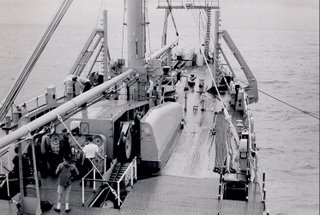

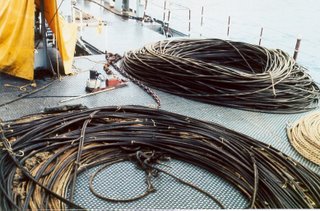
USS Thor (ARC-4) history.
Lots of sea time, not much excitement, except for the mission and the weather.
And the mission? Well, the payoff was pretty big:
As the Cold War deepened, and both the size and capability of the Soviet submarine fleet continued to grow, SOSUS became "the secret weapon" that enabled U.S. ASW forces to keep close track of virtually all potentially hostile submarines operating in the deepwater regions off both coasts. This capability was facilitated by geographical constraints that forced Soviet submarines into predictable deployment patterns and the rudimentary state of Russian acoustic quieting, which left their submarines some 30 dB noisier than U.S. counterparts - and hence easily detectable from thousands of miles away. In the mid 1980s, the network of fixed SOSUS arrays was augmented by a small fleet of civilian-manned, ocean-going, acoustic surveillance ships deploying the Surveillance Towed Array Sensor System (SURTASS), a towed line array over 8,000 feet long.5 By means of satellite communication links, contact information developed by the SURTASS ships at sea was passed to the SOSUS Evaluation Centers ashore and melded with data from the fixed arrays to establish position estimates for likely targets. In time, the totality of fixed arrays, shore processing facilities, and SURTASS ships became known as the Integrated Undersea Surveillance System (IUSS).But while it worked, it worked well. And the men that laid those arrays and served in the ARCs deserve a salute!
Eventually, with the help of key information supplied by the Walker-Whitworth espionage ring6, Soviet intelligence learned of the existence of SOSUS and its remarkable success in tracking Soviet submarines at long range. Thus, beginning shortly after John Walker's first treasonous revelations in 1968, the Russian navy embarked belatedly on a rapid submarine quieting program, and within five years, the radiated noise levels of their first-line boats had begun to drop recipitously. By the end of the Cold War in the late 1980s, Russian submarines were much closer to their U.S. equivalents, and the ability of IUSS to detect and track them at long range had deteriorated significantly...
All the cable ships are now gone, except for one operated by the Military Sealift Command, USNS Zeus (T-ARC-7).
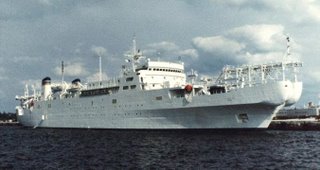
SOSUS was declassified in 1991, and now gets used by NOAA and others. Some of the hydrophones are used to locate earthquakes:
The Acoustic Monitoring Project of the VENTS Program has performed continuous monitoring of ocean noise since August, 1991 using the U.S. Navy SOund SUrveillance System (SOSUS) network and autonomous underwater hydrophones.Some of the sounds recorded by NOAA hydrophones are available for you to listen to here.
 The laying of NOAA hydrophones is shown in the photograph.
The laying of NOAA hydrophones is shown in the photograph.
An Asian joint maritime exercise

The way to learn to work together is to train together, and The Asean Regional Forum (ARF) has been doing that:
The Asean Regional Forum (ARF) has conducted its first-ever exercise, known as Maritime Security Shore Exercise, here.
The two-day exercise, which ended today, was also the first time that member countries had come together for an operational activity under the ambit of the ARF, Singapore's Ministry of Defence said.
"The multilateral shore exercise was designed to promote interoperability and familiarity among the various agencies involved in enhancing maritime security," the ministry said in a statement released at the end of the exercise.
Maritime security experts from the military, law enforcement, port, and policy agencies of ARF member countries participated in a series of inter-agency discussions and table-top exercises.
A simulation exercise was also held at the Singapore navy's tactical training centre at the Changi naval base, which focused on inter-agency as well as international information-sharing and collaborative sense-making, it said.
A total of 102 officials from 21 of the 26 ARF member countries participated in the exercise which the ministry described as a reflection of the recognition by ARF members that multilateral cooperation was necessary to address the transnational nature of maritime challenges.
Port cargo screening provisions unlikely to survive

Reported here, the effort to grind the import of cargo into the U.S. to a dead stop is not likely to make it past the Senate:
House-passed requirements for intensified screening of cargo on passenger aircraft and ship-borne goods heading toward the U.S. are unlikely to survive in the Senate, a House leader on security issues conceded Wednesday.100 Hours? Reminds me of those lyrics from a Dylan song: "You just kinda wasted my precious time..." Only it's not all right.
We need to get adult about port security.
Railroad tank cars cause some concern


Possible railroad tank car dangers expressed in Tankers of Mass Destruction:
TO THE THOUSANDS of residents and commuters who see them each day, the big steel tanker cars are ubiquitous features of the Bay Area's transportation landscape, parked on railroad sidings along with low-profile container carriers, steel-mesh auto carriers and bulging grain hoppers.An earlier warning piece from the Pittsburgh Tribune-Review.
But to terrorism experts, emergency officials and chemical hazard researchers, they are lurking weapons of mass destruction, waiting for mishap or sabotage to set them off.
At a U.S. Senate hearing Jan. 18 the problem of highly hazardous chemical rail tankers in urban areas was listed as the Transportation Security Administration's second biggest threat to surface transportation, after direct threats to passenger rail systems that travel beneath the ground or water.
More than 100,000 tankers full of toxic inhalation hazard chemicals, such as chlorine and ammonia, are shipped through the nation annually out of a total of about 1.2 million tankers carrying materials considered hazardous in varying degrees.
***
Liquid petroleum gas, also called propane, sits in strings of black tanker cars on sidings between the Bay shore's refineries from Richmond to Martinez and beyond.
A ruptured car could lead to something safety experts call a BLEVE* (pronounced "blevy") — boiling liquid expanding vapor explosion — said Koopman, who actually ruptured chemical tanker trucks at a nuclear weapons test site in Nevada to record the results.
"A really big release outside can explode," Koopman explained. "The fire would heat the other propane cars until they explode, and that creates a huge explosion."
Koopman said he believes LPG is even more dangerous than the controversial liquid natural gas, which environmental activists have staged a high-profile campaign against bringing to California.
New rail couplers and steel plates have reduced the chances of an accidental rail car puncture, he said, but would not stop an act of sabotage.
And the number deaths from BLEVE explosions from rail tank cars in American history? Well, 16 in Waverly, TN in an accident involving a single walled tanker. More on Waverly here.
Two fire fighters in Iowa in 1998 and
NFPA's fire investigations database turned up two similar fatal fires that took place on farms in 1993 and 1997, the first in Warwick, Quebec, Canada, and the second in Illinois. Like the Albert City fire, these two occurred on farms where propane was used to heat buildings. In each case, the tanks' relief valves were operating when firefighters arrived, but they couldn't stop flames from impinging on the tanks and weakening the tank shells. And in each case, tanks ruptured in BLEVEs that sent pieces of metal flying at high velocities in random directions, killing those caught in their path.But:
Back in the '60s and '70s, when derailments of rail cars carrying liquid propane posed a real challenge, the railroads, the gases industry, and the fire service all worked to improve LP-Gas storage, handling, and firefighting. One of the best-known railroad incidents occurred in Crescent City, Illinois, in 1970, when 10 tank cars carrying more than 34,000 gallons (128,700 liters) each derailed. Three BLEVEs resulted, generating enough force to blow people, railroad ballast, ties, and track into the street, destroying most of the business district and several homes. Sixty-four people, many of them firefighters, were injured.
After several BLEVEs of this type, the railroad industry retrofit all tank cars carrying liquefied flammable gases by adding thermal protection, which protects against high temperatures that can weaken metal. Shelf couplers were also developed to prevent cars from uncoupling vertically, and head shields were fitted to protect against punctures from the couplers. Since these retrofits were completed in 1980, there have been no BLEVEs of tank cars in the United States.BLEVE explained:
Under rapid heating (for example, from a pool fire engulfing the tank), a tank containing pressurized liquid may fail suddenly producing an explosive effect. The liquid in the tank absorbs energy from the surrounding fire and heats up rapidly. The resulting increased rate of vaporization produced increases the ullage pressure. When this pressure exceeds a certain limit (characteristic of the material properties of the tank wall, wall thickness and temperature), the tank fails. The liquid released from the tank boils rapidly and expands. The resulting explosion may fragment the tank into pieces and propel them over large distances. If the hazmat is flammable, it may ignite and form a fireball posing additional hazard. This phenomenon is called a BLEVE or Boiling Liquid Expanding Vapor Explosion.Remember the difference between the pressurized LPG carriesd by the railroads and the unpressurized LNG carried by LNG tankers. No BLEVE with LNG.
Somali Pirates Coming Back?

Maybe. See Pirates Gather At the Coastal Town of Haradhdere:
The government administration in Mudug provincial town of Haradhere, central Somalia, has voiced concerns that the Somali pirates have begun massing at the town. The pirates were reportedly intending to launch hijacking the ships crossing Somalia coasts.
Abdisalna Khalif, the government management for Mudug region, has told Shabelle by the phone that groups of heavily armed pirates have lately been gathering at Hardhere town, which was notorious for piracy in the past.
Saturday, January 27, 2007
At a conference
No, I haven't gone away.
Just at conference away from the home port.
Thanks for wondering.
Just at conference away from the home port.
Thanks for wondering.
Thursday, January 25, 2007
Latest ONI Worldwide Threat to Shipping (to 17 Jan 07)


Latest ONI Worldwide Threat to Shipping (to 17 Jan 07) here:
Lots of robberies in port, some attempted boardings at sea.
And anti-whaling terrorism:
1. ANTARCTIC ANTI-WHALING EFFORTS: According to a 23 DecMore on "Sea Shepard" at their site. Note the pirate flags on the ships. Given that international law treats pirates rather rudely...
Sea Shepherd news release, The (FARLEY MOWAT) is expected to arrive
in the whaling area during the first week of Jan, where the flagship will
rendezvous with the organizationís newly acquired second ship, code-named
LEVIATHAN. The two ships, with over 60 international volunteers, a
helicopter, and numerous smaller vessels, will confront the Japanese whalers
on the high seas. According to a statement from the International Merchant
Marine Registry of Belize, the (FARLEY MOWAT) was deregistered on
Dec 29, after only ten days of issuance, citing concerns the vessel would be
used as part of an organized attempt to sink whaling ships. A Sea Shepherd
news release dated 05 Jan confirmed the vessel is now officially operating
without a flag. However, the Sea Shepherdís president told reporters that he
had no intention of endangering lives. Additionally, the Greenpeace ship
(ESPERANZA) arrived in Auckland, New Zealand on 09 Jan and is expected
to depart in two weeks to take part in efforts to stop whaling as well. This
year, the Japanese Fisheries Agency plans to hunt 935 minke whales and
10 endangered fin whales. ONI Comment: Last season, dangerous hull-to-hull
contact (both accidental and intentional) was reported between protest vessels
and whaling vessels. While this does not pose a threat to merchant shipping
in general, vessels and regional rescue authorities should be aware of the
possible need to render emergency assistance if operating in the vicinity of
the Ross Sea from now to the end of the whaling season, which last year ended on March 20 (ONI, GP, LL, seashepherd.org, LM: The Age, Sydney
Morning Herald).
See here at UNITED NATIONS CONVENTION ON THE LAW OF THE SEA:
Article 100UPDATE: Of course, Sea Shepard asserts that it is enforcing UN Conventions. See here, too.
DUTY TO CO-OPERATE IN THE REPRESSION OF PIRACY
All States shall co-operate to the fullest possible extent in the repression of piracy on the high seas or in any other place outside the jurisdiction of any State.
Article 101
DEFINITION OF PIRACY
Piracy consists of any of the following acts:
(a) any illegal acts of violence or detention, or any act of depredation, committed for private ends by the crew or the passengers of a private ship or a private aircraft, and directed:
(i) on the high seas, against another ship or aircraft, or against persons or property on board such ship or aircraft;
(ii) against a ship, aircraft, persons or property in a place outside the jurisdiction of any State;
(b) any act of voluntary participation in the operation of a ship or of an aircraft with knowledge of facts making it a pirate ship or aircraft;
(c) any act of inciting or of intentionally facilitating an act described in subparagraph (a) or (b).
Article 102
***
DEFINITION OF A PIRATE SHIP OR AIRCRAFT
A ship or aircraft is considered a pirate ship or aircraft if it is intended by the persons in dominant control to be used for the purpose of committing one of the acts referred to in article 101. The same applies if the ship or aircraft has been used to commit any such act, so long as it remains under the control of the persons guilty of that act.
Article 104
RETENTION OR LOSS OF THE NATIONALITY OF A PIRATE SHIP OR AIRCRAFT
A ship or aircraft may retain its nationality although it has become a pirate ship or aircraft. The retention or loss of nationality is determined by the law of the State from which such nationality was derived.
Article 105
SEIZURE OF A PIRATE SHIP OR AIRCRAFT
On the high seas, or in any other place outside the jurisdiction of any State, every State may seize a pirate ship or aircraft, or a ship or aircraft taken by piracy and under the control of pirates, and arrest the persons and seize the property on board. The courts of the State which carried out the seizure may decide upon the penalties to be imposed, and may also determine the action to be taken with regard to the ships, aircraft or property, subject to the rights of third parties acting in good faith.
MSC Napoli Update: Help is on the way

BBC report on aid headed to the stricken ship:Crane barges sail to Napoli's aid.
Two specialist crane barges are sailing from Rotterdam in the Netherlands to join the operation to salvage the cargo of beached container ship MSC Napoli.
They will start lifting the remaining 2,394 containers off the ship, grounded off Sidmouth in east Devon, on Friday.
A team of 20 is working round the clock to pump oil from the ship - 200 tonnes have already leaked into the sea.
On Thursday the Maritime and Coastguard Agency said no oil had leaked overnight and no more containers had been lost.
Wednesday, January 24, 2007
"Anti-Accomplices" at InstaPunk
TruePunk at InstaPunk has got his game face on and is taking names here, which must be read in its entirety.
Underlying it all, in the war against Islamofascists, is this: "Lead, follow, or get the out of the way!"
UPDATE: Proper credit assigned.
Underlying it all, in the war against Islamofascists, is this: "Lead, follow, or get the out of the way!"
UPDATE: Proper credit assigned.
National Defense Exemption for Sonar Training
Some common sense at work here:
Following consultation with the Department of Commerce, the Department of Defense today announced authorization of a two-year National Defense Exemption from requirements of the Marine Mammal Protection Act (MMPA) for naval activity involving mid-frequency active sonar use, and a new sensor that uses small explosive charges, during major training exercises and on established ranges and operating areas. This period provides the Navy time necessary to continue coordination with the National Oceanic and Atmospheric Administration (NOAA) and the public as the Navy continues its analysis of activities on major range complexes and obtains any necessary authorizations from NOAA.
The Navy’s position is that continued training with active sonar is absolutely essential in protecting the lives of our Sailors and defending the nation. Increasingly quiet diesel-electric submarines continue to proliferate throughout the world. “The Navy has worked closely with the National Oceanic and Atmospheric Administration on our long-term compliance strategy, and the National Defense Exemption is an agreed upon part of the strategy. It allows both agencies to apply resources to the long-term plan,” said Navy Rear Adm. James Symonds, director of environmental readiness. “We will continue to employ stringent mitigation measures, developed with NOAA’s concurrence, to protect marine mammals during all sonar activities.”
Tuesday, January 23, 2007
MSC Napoli update: "Sheer greed" on the beach
BBC says Ship's scavengers ignore police:
Hundreds of people are continuing to rummage through cargo from the stricken ship MSC Napoli despite police road blocks and warnings to stay away.More here and here, which includes report that some of the goods looted have shown up on Ebay,
Over the last two days scavengers have descended on the beach in Branscombe, Devon, taking away goods that included BMW motorbikes, wine and nappies.
Officers closed the beach to deter treasure seekers and to allow contractors to start the clear-up.
Coastguard officials have accused scavengers of "sheer greed".
Iraqi pirates off Kuwait

Reported here:
Iraqi pirates kill 1, hurt 1: The remains of an unidentified Iranian man, who was killed by unidentified pirates off Bubiyan island inside Kuwait's territorial waters, have been referred to Forensics, reports Al-Anba daily. Another Iranian, who survived the attack and is believed to be suffering from gunshot wounds, has been admitted to the Amiri Hospital in critical condition. A security source said sea rescue men rushed to the area after the Coast Guard department received an SOS message from another Iranian boat in the vicinity — west Bubiyan Island — informing about the attack on another vessel by some men believed to be Iraqi pirates.
The pirates allegedly shot and killed one man and injured another before escaping with the merchandise from the boat.
An unidentified source said it is surprising the pirates entered Kuwait's territorial waters, committed the crime and escaped. Can the incident be attributed to lack of security, the source wondered.
Sri Lankan government continues media jujitsu
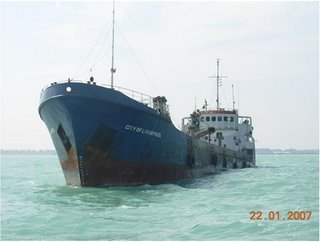
The Tamil Tiger rebels of Sri Lanka are not only taking hits from a military offensive being waged by the Sri Lankan governemnt, their "pirate-like" behavior is being used in a media campaign to disabuse the world of any idea that the Tigers are "fluffy bunny" renegades. One example of this media juitsu is found here:
The Tiger attack on the cargo ship "City of Liverpool MV” that transported food to Jaffna signals a serious threat to (1) international shipping in the Indian Ocean and (2) the supply food and essential items to the people of Jaffna through the sea route, according to analysts.Previous post on the Sea Tiger attack on "City of Liverpool" here.
This is the second Tiger attack on ships within two weeks. On 23 December 2006, the Tigers hijacked FARAH III carrying 14,000 MT of rice from India to S. Africa. On Sunday, (21, January 2006) a cluster of Tigers boats approached "City of Liverpool MV” berthed in the Point Pedro Sea in an attempt to sink it. But a three pronged attack from air, land and sea drove the Tigers away. Two Tiger boats were completely destroyed. One Tiger boat managed to break through and hit the hull causing it to leak. Navy has rushed to repair the damage and take it to Kankesanthurai.
In the past, the LTTE has hijacked several vessels. Some of the reported cases relate to the hijacking of Irish Mona (August 1995), Princess Wave (August 1996), Athena (May 1997), Misen (July 1997), Morong Bong (July 1997), Cordiality (Sept 1997) and Princess Kash (August 1998). M V Cordiality, was captured by the LTTE and five Chinese crew were killed allegedly by Sri Lankan terrorists near the port of Trincomalee.13 Princess Kash, a Belize flagged general cargo vessel was hijacked by LTTE rebels, while on its way to Mullaitivu, a LTTE stronghold. The Sri Lankan Air Force bombed the vessel to prevent the ship's cargo falling into the hands of the LTTE. The status of the 22-crew members is still not known.
The Tiger attack on ships carrying food and essentials to the people of Jaffna is also seen as a deliberate attempt to create a food shortage and a humanitarian crisis which could be used to blame the Sri Lankan government. The Tiger tactic has been to block supplies of food to Jaffna and then complain to the international community that the Sri Lankan government is depriving the people of Jaffna food.
Given that the Tigers are given credit for initiating the modern use of suicide bombers and terrorist tactics at sea, they seem to be a group only their fellow Tigers can love.
Monday, January 22, 2007
MSC Napoli: What the crowds are doing is wrecking

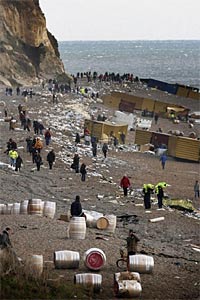
Along with piracy, one of the ancient arts of intercepting commerce is wrecking:
Wrecking is the practice of taking valuables from a shipwreck which has foundered near or close to shore.
This practice is often illegal and equivalent to looting. In the United Kingdom, in many cases, the ship and cargo remain the property of the original owners and all salvaged articles must be reported to the Receiver of Wreck so that ownership can be determined.
In some cases ships were deliberately lured into danger; for example by faking the signals from lighthouses, so that the ship was wrecked and the cargo could be plundered. Wrecking is no longer economically significant, however as recently as the 19th century in some parts of the world it was the mainstay of many otherwise economically marginal coastal communities.
Wrecking was well known in Cornwall, where the rocky coastline, strong prevailing onshore winds and (sometimes) the display of false lights led many ships to disaster (this is also true in other parts of the celtic seaboard, such as South-west Ireland, the Vale of Glamorgan in Wales and Finistere in Brittany). Rather than helping shipwrecked sailors, the wreckers often murdered and stripped them of their possessions, for example Sir Cloudesley Shovell. The ships themselves were looted for their cargoes.
Prior post on ship wreckers here. It seems English law is somewhat unique in its treatment of flotsam and jetsam.
UPDATE: More here. SMIT salvage has the contract to salvage the ship.
Maritime Monday 43 at Fred Fry International
Lots of maritime topics covered at Fred Fry International: Maritime Monday 43, including OPDS and other interesting matters of a nautical bent.
Go, see for yourself.
Go, see for yourself.
Piracy attacks down in 2006
Reported as Global pirate attacks in 2006 dip to lowest in 8 years:
Indonesia remained the world's hottest piracy hotspot with 50 attacks last year, but this was a marked improvement from 79 cases in 2005, the IMB report said.
But the situation has deteriorated in Bangladesh as cases of sea attacks more than doubled to 47 last year, the IMB said. Chittagong port, where most of the cases occurred, has been listed as the world's most dangerous port, it said.
Nigeria has 12 pirate attacks, the third highest, it said. Last year, 49 people, mostly foreign oil workers, were kidnapped and three killed, the report said.
Attacks in the busy Malacca Strait, which carries half the world's oil and more than a third of its commerce, have been on the decline since July 2005 with 11 cases last year, it said but warned ships to maintain a strict watch when transiting the waterway.
Update on damaged container ship MSC Napoli
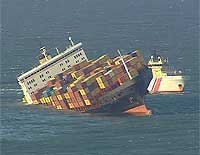
Good updates with photos at Cargo Law (which is a slow loading site due the photos and you have to scroll down to find them -be patient, it's worth the wait) - ship developed a crack in hull, crew abandoned ship and was recued by Royal Navy. Now efforts underway to salvage what can be salvaged. Hundreds of containers lost or adrift.
Ship has been beached to stop her sinking. Recovery efforts underway.
Interesting photos here.
Previous post on MSC Napoli.
Sri Lanka government reports Tamil "Sea Tigers" attack humanitarian ship in port



Set out here:
02 CLUSTERS OF SEA TIGER BOATS today (21) attacked the ship "CITY OF LIVERPOOL" around 3.45 p.m. while unloading foodstuffs at POINT PEDRO harbour.Photo of ship is believed to be that of "City of Liverpool." Earlier post on "sea tigers" here.
The Navy immediately came to the assistance of the besieged ship and in the ensuing confrontation in the South East of the POINT PEDRO sea, two suicide LTTE boats have been completely destroyed.
Naval troops had observed 15-20 sea tiger boats sailing from VETTALAIKERNI to POINT PEDRO. The Naval troops reached the sea tiger boats while, at the same time the anchor was released and the ship sailed towards KANKESANTHURAI, when 5-6 sea tiger boats began to pursue the ship. Then, the naval crew of the ship fired at the sea tiger boats. One boat was destroyed when the crew of ship "CITY OF LIVERPOOL" fired at the cluster of boats. The hull of the ship had been damaged slightly in the blast of the suicide boat.
Two sea tiger boats had been destroyed by the naval attack.
The naval troops on security on board the ship had fired at the sea tiger boats and one was destroyed completely, making the total of boats to 03.
Sunday, January 21, 2007
Sunday Ship History: U.S. Navy's First Missile Submarines

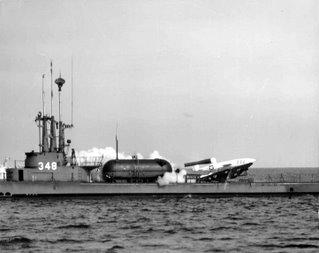
USS Cusk (SS-348) was the first submarine of the United States Navy (and perhaps the world) to fire a guided missile.
And it's due in part to the work of German scientists.
What those German scientists started with their rocket programs! Today there are ballistic missiles (submarine and land launched) , cruise missiles, and so on.
Once, however, there were the German rockets and a race to develop delivery systems for American and Soviet adaptations of a "proven" technology.
Both sides were also quick to take advantage of captured German V-1 and V-2 technology from World War II to begin development of both guided and ballistic missiles for tactical and strategic use, with the U.S. Army initially taking the lead in the United States. Not to be out-done, the U.S. Navy converted two World War II fleet boats, USS Carbonero (SS-337) and USS Cusk (SS-348) to carry a U.S. variant of the German V-1 pulse-jet missile, known as the Loon, first launched at sea in February 1947. Loon's nominal range under command guidance was approximately 50 nautical miles, but using a second submarine as a relay, it could be effective out to 135 nautical miles, with a reported Circular Error Probable (CEP) of 6,000 yards.From here:
Soon a team of engineers, submariners, aviators and former German rocket scientists assembled at the Naval Air Missile Test Center, Point Mugu, California, to begin tests with the "Loon" - the Americanized V-1. Despite the simplicity of the bird (which was powered by a primitive pulse jet engine), it was clear that modifying it for submarine launch would be difficult. The first step threatened to be the most troublesome: how to launch the Loon off the tiny deck of a submarine. The Germans had used long catapult ramps to accelerate their missiles, and now engineers struggled to develop a rocket sled to achieve the same result in a minimum distance. Tests produced some spectacular failures as rockets exploded, sleds failed, and pulse jets stalled. Eventually however, the bugs were worked out and rocket launches of Loons became routine.As an aside, Steeljaw Scribe in his most recent "Flightdeck Friday" has a picture of a V-2 rocket being launched from the deck of a U.S. aircraft carrier.
While rocket tests proceeded, another team of engineers tackled the complicated issue of how to control missiles in flight. The Naval Electronics Laboratory set about building a radio control system, using an existing radar beam. "Submarines had two radars: an air-search radar and a surface-search radar," says Captain Al Thomas, USN (ret.) who participated in some of the tests. "And they decided to modify the air-search radar so that you could send codes. You could make the missile go faster or slower or higher or lower, or right or left, or tell it to dive in." That made the Loon not just a flying bomb, but a true guided missile.
The World War II fleet submarine USS Cusk was then outfitted with a launch ramp and a missile control station. On March 7, 1947 Captain Fred Berry watched the action of the waves through the periscope. When the Cusk was in the trough of a wave, he gave the order to launch. Smoke from the rockets obliterated Berry's view as the Loon leapt off the deck. Controlled by the submarine and then by a chase aircraft, the missile was flown for several miles and "dumped" on a target. The Cusk had just made history.

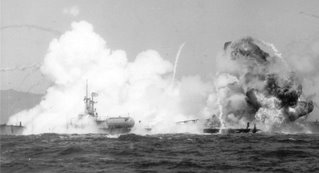
Things did not always go smoothly:
But on 7 July 1948, something went horribly wrong. "One of the rocket bottles exploded on the deck (of the Cusk)," recalls Thomas. "And the missile, which was full of JP-5, like kerosene, exploded and dove down on the deck of the submarine." Horrified onlookers saw the boat disappear beneath a towering fireball and smoke cloud. "Everyone thought the Cusk had sunk," remembers Captain Pat Murphy, USN (ret.) another Loon-era veteran. "But the Cusk's captain [Fred Berry] saw what happened through the periscope and saw that there was no hull rupture. Well, he submerged. They had all the water they needed to put out the fire."Some more background here:
The Cusk survived with minor damage. In 1949, she and a sister ship, the USS Carbonero, launched a missile attack as part of an exercise. Although the Cusk's Loon malfunctioned and crashed, the Carbonero's flew over the fleet, despite the use of radar, fighter interdiction, and heavy anti-aircraft fire. It was a terrific demonstration. But the Loon was not a practical weapon. Its payload and range were small, and new aircraft could out-fly it easily. "We were walking before we learned to run," says Murphy. "We were saying, this is what we can do, now give us the resources so that we can go do it."
"Loon" history here:The Carbonero and the USS Cusk SS348 were selected to participate in the new Guided Missile Program in April 1947. Captured German V-1 "buzz bombs" were altered for remote control (renamed "Loons") and launched from a railing mounted on the after decks. The primitive control system consisted a modified air-search radar sending signals to speed up or slow down, go left, right or "dump" i.e. dive on the target.
These tests were conducted off Pt. Mugu, California and Oahu, Hawaii for several years and lead to the development of the Regulus Missile system. Carbonero later had the launching rail removed and became a guidance station boat, performing as an intermediate steering point on the missile's path to its target. The Regulus guidance equipment was removed in early 1962.
The Loon was the U.S. Navy's copy of the German V-1. The U.S. Army Air Forces' copy was designated JB-2. Intended for launching from ships against ground targets, the Loon had a pulse jet engine, a range of 150 miles, and was tracked by radar and controlled by radio. All Loons built were used in tests after the war. None were fired in combat.
The Loon was the Navy version of the JB-2, the copy of the German V-1 developed by the Army Air Forces (AAF) beginning in 1944. As with the V-1, the AAF intended the JB-2 to be a ground-launched missile used against ground targets. The AAF started flight tests in October 1944. The Navy developed interest in the AAF program shortly thereafter, intending to launch the missile from escort carriers with guidance from either shipboard or airborne radar.
Formally, the Navy's project was initiated under the Bureau of Aeronautics in April 1945 and at that time the missile was designated the Loon. (Initially, the Navy also designated the Loon as KGW-1 then in 1946 redesignated it as KUW-1.) The Bureau of Aeronautics received some JB-2s from the AAF, and in June 1945 contracted with Republic Aviation for 151 missiles. The XM-1 system (using a slotted tube powder catapult) was selected for the launching system.
The Loon was 27 feet long and had a wing span of 18 feet. It carried a 2,100 pound warhead and weighed 5,020 pounds with the warhead and fully fuelled. Powered by a PJ 31-1 pulse jet which developed a gross thrust of 850 to 900 pounds at a specific impulse of about 1,100 pounds per second, the Loon had a 180 gallon tank and could use any gasoline-type fuel. Control surfaces on the airframe consisted of rudder and elevators only. The Loon was tracked by radar to the target and was controlled by radio. Stabilization was provided by 3 air-driven position and rate gyros. An aneroid unit and magnetic compass controlled altitude and course through the gyro system.
 The Cusk website points out that the movie "The Flying Missile" (as opposed to what? "The Walking Missile?") was loosely based on the Cusk launches - and starred Glenn Ford, Capt, USNR. Launch video can be downloaded here.
The Cusk website points out that the movie "The Flying Missile" (as opposed to what? "The Walking Missile?") was loosely based on the Cusk launches - and starred Glenn Ford, Capt, USNR. Launch video can be downloaded here.Well, way back when. A salute to the pioneers of Cusk and Carbonero!
Top Loon launch photos from here (explosion photo attrib to Ric Hedman). Lower photos are of USS Carbonero from here.
Al Gore chooses not to debate "Truth"
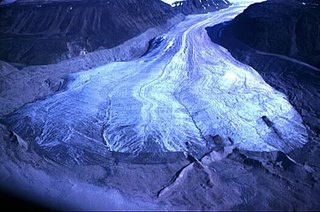
Most people who have facts to support their case are happy to engage is spirited debate. Al Gore either lacks the facts or the courage to debate environmental matters, as set out here:
But if we are to follow Mr. Gore's suggestions of radically changing our way of life, the costs are not trivial. If we slowly change our greenhouse gas emissions over the coming century, the U.N. actually estimates that we will live in a warmer but immensely richer world. However, the U.N. Climate Panel suggests that if we follow Al Gore's path down toward an environmentally obsessed society, it will have big consequences for the world, not least its poor. In the year 2100, Mr. Gore will have left the average person 30% poorer, and thus less able to handle many of the problems we will face, climate change or no climate change.30% poorer? I guess that millionaire former senators and vice presidents won't feel the heat from that, but for those of us who have to try to get the left end and the right end to meet in the middle should feel a chill from that.
By the way, I am not a believer in man-caused global warming, though I am willing to hear some serious discussion.
And not by Al Gore, who has proven, once again, that he is not a serious person.
UPDATE: Debate this. The comment section is open.
UPDATE2: The picture is of a glacier. Once upon a time, much of the northern hemisphere was covered with ice. Now it is not. Much of the ice disappeared long before man developed large "climate changing" industry. What caused the ice to melt? Commonsense says it's part of a normal cycle of climate changes.
Saturday, January 20, 2007
Sailors kidnapped off Nigeria
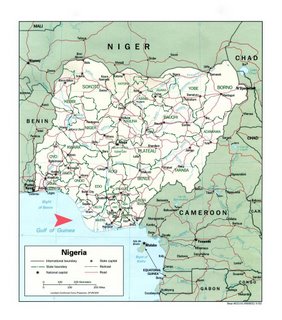
One of the most active piracy areas is the Niger River delta, where hostages have grabbed 6 Filipino sailors and one Nogerian, as reported here:
Seven seamen, including six Filipinos, were kidnapped from a cargo ship on a river in Nigeria's southern oil producing delta on Saturday, military and oil industry sources said.Ah, the old protection reacket...
The incident brings to nine the number of foreign workers being held hostage in the world's eighth largest oil exporter, where militant attacks have reduced oil output by a fifth.
"Six expatriates and one Nigerian were kidnapped off a vessel on Chanomi Creek in Delta State," said an oil industry source, who asked not to be named.
Other sources said the foreign hostages were Filipino, taken from a cargo ship operated by Germany's Baco-Liner, based in Duisburg, which runs between Europe and several ports across West Africa.
***
Militants and criminals seeking ransoms have kept up a series of attacks and kidnappings against foreign workers in the Niger Delta, a vast wetlands region which is home to all of Nigeria's oil resources.
Militants want to drive out foreigners and secure more regional control over the delta's oil wealth. The region is also blighted by violent crime, communal conflicts and corruption.
Ships entering Delta State are often harassed by pirates from local communities who demand protection money.
Friday, January 19, 2007
The Inflation-Adjusted Price of Oil
The people at Chart of the Day offer up this chart:

And this comment:

And this comment:
The price for a barrel of crude oil continues to decline and now trades below $51. While the price is nowhere near inexpensive, it has been heading in the right direction. For some perspective, today's chart presents the current trend in the price of one barrel of oil. As the chart illustrates, oil has broken below trend (see green dashed line).I wonder how much media coverage this will get? Surely just as much as when the price of crude was bumping upwards - right?
Thursday, January 18, 2007
The Qur'anic Concept of War
Jihad Watch gets the hat tip for its post The Qur'anic Concept of War, which in turn links to this Army War College Parameters article. The article may help get your head wrapped around a couple of hard concepts:
The Quran is presumed to be the revealed word of God as spoken through his chosen prophet, Mohammed. According to Malik, the Quran places warfighting doctrine and its theory in a much different category than western thinkers are accustomed to, because it is not a theory of war derived by man, but of God. This is God’s warfighting principles and commandments revealed. Malik’s attempts to distill God’s doctrine for war through the examples of the Prophet. By contrast, the closest that Clausewitz comes to divine presentation is in his discussion of the trinity: the people, the state, and the military. In the Islamic context, the discussion of war is at the level of revealed truth and example, well above theory—God has no need to theorize. Malik notes, “As a complete Code of Life, the Holy Quran gives us a philosophy of war as well. . . . This divine philosophy is an integral part of the total Quranic ideology.”Well worth the reading.
USS Trenton transferred to Indian Navy
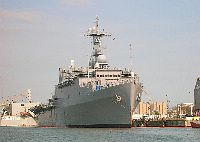
Reported here, the first ever transfer of a U.S. Navy ship to the Indian Navy:
The amphibious transport dock ship USS Trenton (LPD 14), was decommissioned Jan. 17 in a ceremony at Naval Station Norfolk. Immediately following the decommissioning, Trenton was recommissioned and transferred to the Indian Navy, bearing the name INS Jalashwa.Fair winds Jalashwa!
This could be part of a beautiful friendship between two great democracies.
Train like you'll fight: Visit, Board, Search & Seizure
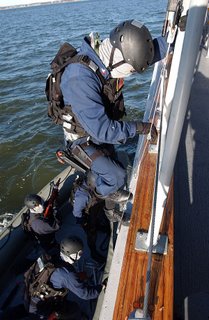
Reported here:
Sailors and assets from the U.S. Naval Academy provided a unique training opportunity Jan. 10 and 17 for the crews of USS Thunderbolt (PC 12) and USS Hurricane (PC 3) in the Chesapeake Bay.I don't know who deserves credit for the idea, but it's a good one.
The exercises were part of Thunderbolt and Hurricane's theater-tailored Advanced Phase Training Exercise, designed to prepare the crews for upcoming deployments.
Patrol Coastal (PC) ships are responsible for conducting Maritime Security Operations to include Maritime Interdiction Operations, as well as visit, board, search and seizures (VBSS) to prevent smuggling, piracy and human trafficking.
The trip to Annapolis afforded the PC crews experience navigating in unfamiliar waters, establishing security measures in an unfamiliar port, and conducting actual VBSS operations using the Naval Academy's yard patrol (YP) craft as exercise suspect vessels.
"The YP gave our VBSS teams an opportunity to actually experience what it's like to hook and pull a vessel that is underway and exposed to all of the elements," said Thunderbolt Commanding Officer Lt. Scott W. Larson.
"We were able to board a real vessel that was moving on water and in conditions that were not ideal," said Lt. j.g. Steve Phillabaum, ThunderboltÂ’s operations officer. "We are used to practicing on a training platform where weather conditions were non-existent. But here we did it out in the cold just after early morning."
The experience was equally beneficial to the Naval Academy Sailors.
"Participating with the crew of the PCs is valuable because the junior Sailors aboard the YP's often have no prior deployments or exposure to shipboard operations, and this gives them a taste of actual boarding and underway operations," said Senior Chief Quartermaster (SW) Herbert Kelton of YP Operations. "Training also reconnects and strengthens our relationship with the fleet."
Photo and article credit to Mass Communication Specialist Seaman Christopher A. Lussier, U.S. Naval Academy Public Affairs.


